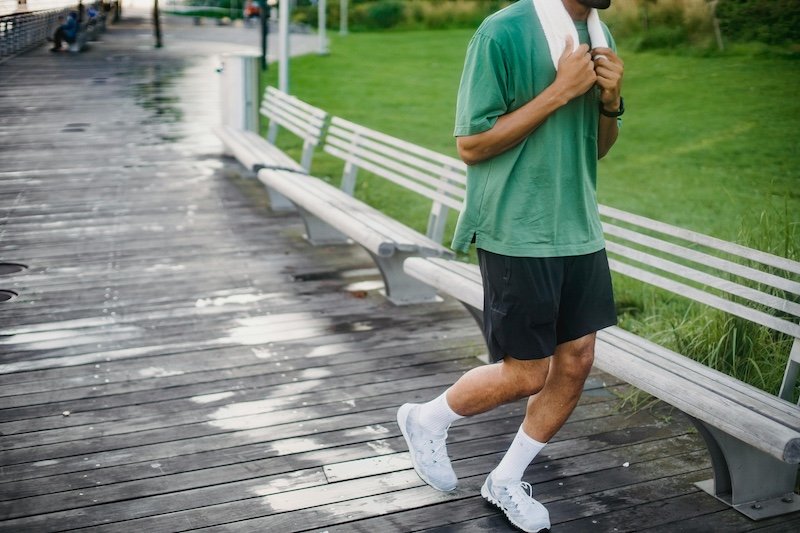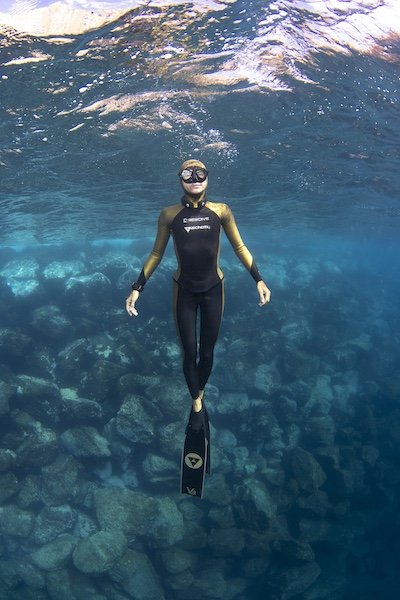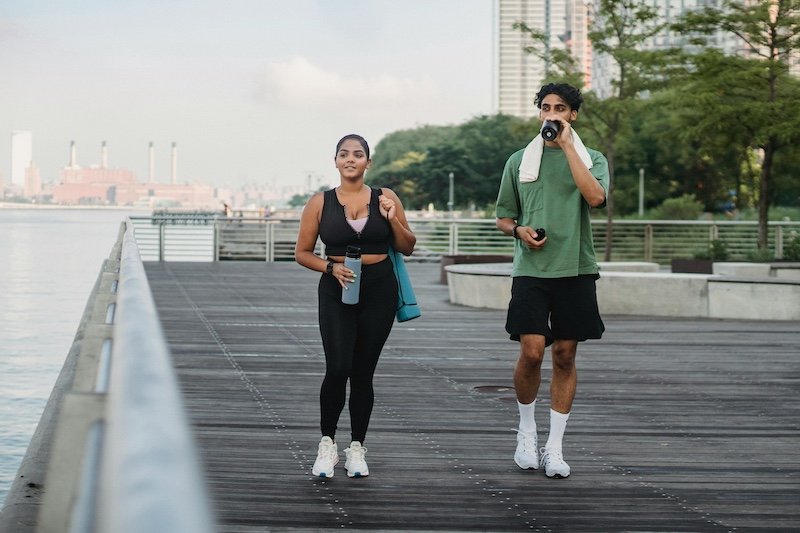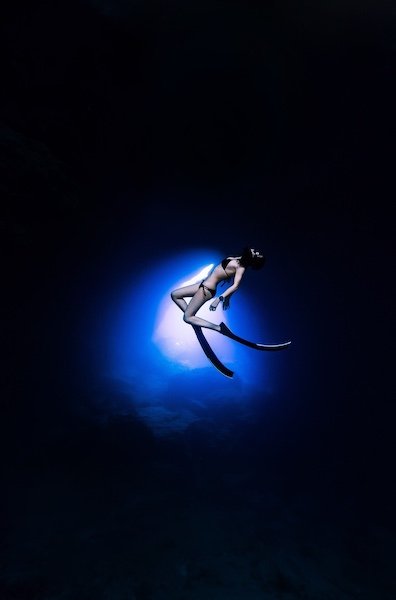
 Katie Wood
Freediver, Writer, Explorer
Katie Wood
Freediver, Writer, Explorer

 Katie Wood
Freediver, Writer, Explorer
Katie Wood
Freediver, Writer, Explorer
When freedivers talk about training, walking rarely enters the conversation. We obsess over CO₂ tables, depth adaptation, dry static holds, pool drills, equalization sessions, and strength work. Our training vocabulary is made of apnea walks, FRC dives, diaphragm stretches, and hypoxic intervals. Walking, in contrast, feels too ordinary, too gentle, too pedestrian to belong in the world of lung squeezes, blackout thresholds, and monofin efficiency. Yet beneath its simplicity lies a physiological power that most freedivers underestimate.
Walking is a rhythmic, low-impact form of movement that engages the cardiovascular system, improves respiratory mechanics, enhances recovery, refines posture, and calms the mind. For freedivers, these benefits are not abstract. They translate into better oxygen economy, improved lung capacity, stronger breathing muscles, faster recovery between sessions, enhanced body alignment in water, and a more regulated nervous system.
While there is little direct research linking walking to freediving performance, the physiological systems that support deep diving respond well to low-intensity aerobic work. Many of the adaptations that allow a freediver to perform calmly and efficiently under water are cultivated more effectively through sustainable, repeated stimuli than through sporadic high-intensity efforts. Walking provides exactly that. It is accessible, repeatable, and easily integrated into a diver’s weekly schedule without adding significant fatigue.
The modern freediver’s world is often fragmented between gym work, pool training, ocean sessions, and recovery. Walking can act as the connective tissue between these elements. It is not a replacement for targeted apnea or depth work, but it is a quiet force multiplier. Once it becomes part of your training ecosystem, its effects ripple through almost every aspect of performance.
Walking improves respiratory function in ways that are directly relevant to freediving. Even at a brisk but conversational pace, the act of walking increases ventilation rate, stretches the thoracic cavity, and strengthens the diaphragm and intercostal muscles. These effects, though subtle, accumulate over time. Regular low-intensity aerobic training has been shown to improve forced expiratory volume and forced vital capacity in adults, indicating better lung elasticity and respiratory muscle endurance. In freediving, where every milliliter of oxygen matters, these improvements give you a more efficient breathing apparatus before you even hold your breath.
The cardiovascular system also adapts to regular walking. Stroke volume increases, resting heart rate decreases, and peripheral capillary networks expand. These changes support oxygen transport and distribution, which is essential for efficient freediving. A diver with a stronger, more efficient heart and denser microvascular networks can deliver oxygen to working tissues more effectively and conserve energy during apnea.
Walking also maintains respiratory health between diving sessions. Freedivers often experience periods where pool or depth training is not possible due to logistics, travel, or recovery needs. During these times, regular walking prevents detraining of the respiratory and cardiovascular systems. It keeps the lungs active, the diaphragm engaged, and the heart trained without imposing high stress. For older divers or those with long competitive histories, walking can help slow the natural decline in lung function that comes with age, preserving thoracic compliance and alveolar health.
The synergy between walking and freediving becomes particularly evident when considering the diving response. A well-trained cardiovascular system enhances the efficiency of the bradycardia and peripheral vasoconstriction mechanisms that freedivers rely on during deep dives. A diver who walks regularly develops a cardiovascular base that supports these reflexes rather than strains under them. Instead of being an afterthought, walking can form the foundation on which more specific apnea adaptations are layered.

Freediving is deceptively intense. Deep dives, repeated breath holds, and heavy pool training impose significant stress on the body. Recovery is often the limiting factor in how much training a freediver can handle, not motivation or technique. Walking provides an elegant solution to this problem.
Low-intensity aerobic activity increases blood flow without adding mechanical or metabolic strain. This improved circulation aids in clearing metabolic byproducts, supporting tissue repair, and restoring homeostasis. A 30-minute walk the day after an intense depth session can accelerate recovery more effectively than passive rest. It helps maintain training rhythm without overtaxing the system.
Recovery in freediving is not just muscular. The nervous system plays a critical role. Deep dives and prolonged breath holds shift the autonomic balance strongly toward parasympathetic dominance, but the process can leave divers feeling fatigued, foggy, or dysregulated afterward. Gentle walking helps the nervous system recalibrate. The rhythmic movement, moderate cardiovascular engagement, and controlled breathing all contribute to restoring equilibrium.
Walking also enables greater overall training volume. Many freedivers hesitate to add aerobic sessions for fear of compromising apnea performance or inducing fatigue. Walking avoids this trap. Because it is low impact and easily scaled, it can be layered between diving days as a recovery modality. Over time, this consistent aerobic base supports more effective adaptation. Divers who build steady-state capacity recover faster between depth days, tolerate higher workloads, and show less performance fluctuation across a training cycle.
In competitive phases, walking can act as a maintenance tool. When dives get deeper and sessions longer, the capacity to handle stress without accumulating excessive fatigue becomes critical. Walking provides a way to keep the system active on rest days, preventing stagnation without interfering with peak performances.

Freediving is as much about how the body moves as it is about how it breathes. Efficiency under water depends on posture, alignment, proprioception, and controlled muscular engagement. Walking might seem distant from this, but its impact on neuromuscular coordination and posture is profound.
The simple act of walking with awareness reinforces upright posture, spinal alignment, and balanced muscular recruitment. Each step involves a coordinated sequence between feet, hips, core, and upper body. Over time, this reinforces postural stability and movement efficiency. Freedivers who spend long hours in static or prone positions often develop compensations, such as rounded shoulders or tight hip flexors, that impair breathing mechanics and finning efficiency. Regular walking counteracts these tendencies by encouraging extension, rhythm, and balanced engagement.
Uneven terrain enhances this effect. Walking on sand, trails, or gentle inclines introduces subtle instability that challenges the proprioceptive system. The small stabilizing muscles of the ankles, knees, and hips become more responsive, while the nervous system refines its control over complex movements. These adaptations translate directly to water. A diver with better proprioception and postural integrity moves through the water with less drag, better balance, and smoother fin strokes.
Walking also strengthens connective tissues in a way that supports freediving longevity. The gentle repetitive loading helps maintain joint integrity and fascia elasticity without overloading the structures. For freedivers who often combine static training with intense dynamic sessions, walking provides the kind of movement variability that keeps the musculoskeletal system resilient.
The benefits are subtle but cumulative. Improved posture leads to better breathing mechanics. Better proprioception leads to more efficient movement. Over months and years, these small improvements can produce meaningful performance gains and reduce injury risk.

Freediving is as much psychological as it is physical. Success in depth disciplines often hinges on the diver’s ability to regulate emotions, manage stress, and maintain focus. Walking plays a surprisingly powerful role in this domain.
Regular walking, especially in natural environments, reduces cortisol levels, lowers perceived stress, and improves mood. The repetitive rhythm of footsteps, combined with controlled breathing, acts as a form of moving meditation. Divers often report that pre-dive anxiety, equalization frustration, or performance plateaus become more manageable when they incorporate regular walks into their routines.
Walking also provides mental space. Freediving training can be intense and highly focused, often revolving around numbers, depth targets, and time benchmarks. Walking offers a contrasting environment: unstructured, calm, and expansive. It gives the mind room to process, reflect, and reset. This is not a luxury. Psychological decompression is critical for sustained high performance. Divers who carry accumulated mental tension into their training often find themselves struggling with breath holds, comfort, or motivation.
In a sport where relaxation under pressure is everything, a calmer nervous system is a competitive advantage. Walking’s ability to modulate autonomic function and enhance emotional regulation is backed by extensive research in exercise physiology and psychology. Freedivers who walk regularly often develop steadier pre-dive routines, experience less variability in mental state, and recover faster from psychologically taxing sessions.

Integrating walking into freediving training does not require elaborate planning. Three to five walks per week, lasting twenty to forty minutes, are enough to generate meaningful benefits. Intensity can vary from easy recovery pace to brisk walks that gently elevate heart rate. Terrain can be chosen based on personal preference, from flat coastal paths to forest trails or urban streets.
Breathing awareness can enhance the effect. Walking with a relaxed belly, open chest, and controlled nasal breathing trains ventilatory patterns that transfer well to freediving. Occasionally incorporating short breath holds during walking can mimic aspects of apnea in a low-stress environment.
The goal is not to replace freediving-specific training but to build a physiological and psychological foundation that supports it. Walking fills the gaps between intense sessions, keeps the respiratory and cardiovascular systems active, reinforces posture, calms the mind, and maintains consistency through seasonal or logistical disruptions.
For divers living in cities far from the sea, walking offers a way to stay connected to their training identity without requiring specialized equipment or access to a pool. For elite competitors, it acts as a recovery tool that preserves performance capacity during demanding training cycles. For beginners, it is a gentle entry point that builds baseline fitness without overwhelming the body.
The beauty of walking lies in its simplicity. In a sport that often romanticizes extremes, it serves as a reminder that foundational habits sustain peak performances. Freediving is not only about the moments spent in the deep. It is also about how you prepare on land, how you recover, how you breathe, and how you move when you are not diving. Walking may not be glamorous, but it is one of the most potent, sustainable, and underappreciated tools available to any freediver willing to use it.
References
Influence of Walking as Physiological Training to Improve Lung Function in Healthy Older Adults. PMC.
Exercise and Lung Health. American Lung Association.
Your Lungs and Exercise, PMC factsheet.
Physiological Challenges and Adaptations in Competitive Freediving. German Journal of Sports Medicine.
The Role of Training in the Development of Adaptive Freediving Responses. PMC.
Skill building in freediving as an example of embodied culture. Royal Society Publishing.
Fast walking for 15 minutes a day, health benefits. The Times.
The big breath secret: can I improve my lung capacity? The Guardian.
Effects of Physical Exercise on Walking Distance and Functional Limitations in Patients with Chronic Dyspnea. MDPI.
Harvard Health: Exercise to Relax.